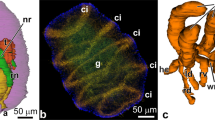Summary
In embryos of the “modern” sea urchin species, subclass Euechinoidea, primary mesenchyme cells are derived from the progeny of micromeres formed at the sixteen cell stage of embryogenesis. The micromeres reside within the vegetal plate epithelium and later ingress into the blastocoel as primary mesenchyme cells which form the larval skeleton. Embryos of Eucidaris tribuloides, a member of the “primitive” subclass Perischoechinoidea, exhibit several noteworthy differences from euechinoid primary mesenchyme cell lineage including variable numbers and sizes of micromeres, the absence of mesenchyme ingression, and the lack of any detectable primary mesenchyme although a larval skeleton forms. In the present study, the cell lineage of the spiculogenic mesenchyme has been studied in Eucidaris tribuloides and in the euechinoid Lytechinus pictus by microinjecting the fluorescent tracer, Lucifer Yellow, into individual blastomeres of the embryo. In addition, wheat germ agglutinin, a lectin which binds only to primary mesenchyme cells of the early euechinoid embryo, was injected into the blastocoel of embryos of both species in order to examine the distribution of cells which possess primary mesenchyme-specific cell surface markers. The results of these experiments demonstrate that the spiculogenic mesenchyme of both Lytechinus and Eucidaris arise from descendants of micromeres formed at the sixteen cell stage, although the temporal and spatial distribution of these mesenchyme cells varies considerably between species. Furthermore, the evidence obtained suggests that the information necessary for spicule formation is already segregated to the vegetal pole by the eight cell stage. The results also suggest that there are no gap junctions present between the blastomeres of the early sea urchin embryo.
Similar content being viewed by others
References
Boveri T (1901) Die Polarität von Oocyte, Ei und Larven des Strongylocentrotus lividus. Zool Jahrb Abt Anat Ontog 14:630–653
Cameron RA, Hough-Evans BR, Britten RJ, Davidson EH (1987) Lineage and fate of each blastomere of the eight-cell sea urchin embryo. Gen Dev 1:75–85
DeSimone DW, Spiegel M (1986) Wheat germ agglutinin binding to the micromeres and primary mesenchyme cells of sea urchin embryos. Dev Biol 114:336–346
Ettensohn CA, McClay DR (1988) Cell lineage conversion in the sea urchin embryo. Dev Biol 125:396–409
Fink RD, McClay R (1985) Three cell recognition changes accompany the ingression of sea urchin primary mesenchyme cells. Dev Biol 107:66–74
Gustafson T, Wolpert L (1967) Cellular movement and contact in sea urchin morphogenesis. Biol Rev 42:442–498
Guthrie SC (1984) Patterns of junctional communication in the early amphibian embryo. Nature 311:149–151
Hall GH (1978) Hardening of the sea urchin fertilization envelope by peroxidase-catalyzed phenolic coupling of tyrosine. Cell 15:343–355
Harkey MA (1983) Determination and differentiation of micromeres in the sea urchin embryo. In: Jeffrey WR, Raff RA (eds) Time, space, and pattern in embryonic development. AR Liss, New York, pp 131–155
Hiramoto Y (1962) Microinjection of live spermatozoa into sea urchin eggs. Exp Cell Res 27:416–426
Horstadius S (1939) The mechanics of sea urchin development, studied by operative methods. Biol Rev 14:132–179
Horstadius S (1973) Experimental embryology of echinoderms. Oxford University Press, London/New York
Katow H, Solursh M (1980) Ultrastructure of primary mesenchyme cell ingression in the sea urchin Lytechinus pictus. J Exp Zool 213:231–246
Kiehart DP (1982) Microinjection of echinoderm eggs: apparatus and procedures. Methods Cell Biol 25:13–31
Kier PM (1974) Evolutionary trends and their functional significance in the post-Paleozoic echinoids. J Paleont [48 Suppl] Paleont Soc Mem 5:1–95
Kitajima T, Okazaki K (1980) Spicule formation in vitro by the descendants of precocious micromere formed at the 8-cell stage of sea urchin embryo. Dev Growth Differ 22:265–279
Langelan RE, Whiteley AH (1985) Unequal cleavage and the differentiation of echinoid primary mesenchyme. Dev Biol 109:464–475
Leaf DS, Anstrom JA, Chin JE, Harkey MA, Showman RM, Raff RA (1987) Antibodies to a fusion protein identify a cDNA clone encoding msp 130, a primary mesenchyme specific cell surface protein of the sea urchin embryo. Dev Biol 121:29–40
Lo CW, Gilula NB (1979) Gap junctional communication in the post-implantation mouse embryo. Cell 18:411–422
McCarthy RA, Burger MM (1987) In vivo embryonic expression of laminin and its involvement in cell shape change in the sea urchin Sphaerechinus granularis. Development 101:659–671
Okazaki K (1960) Skeleton formation of sea urchin larvae: II. Organic matrix of the spicule. Embryol 5:283–320
Okazaki K (1975) Spicule formation by isolated micromeres of the sea urchin embryo. Am Zool 15:567–581
Pehrson JR, Cohen LH (1986) The fate of the small micromeres in sea urchin development. Dev Biol 113:522–526
Raff RA (1987) Review: constraint, flexibility, and phylogenetic history in the evolution of direct development in sea urchins. Dev Biol 119:6–19
Sanger JM, Pochapin MB, Sanger JW (1985) Midbody sealing after cytokinesis in embryos of the sea urchin Arbacia punctulata. Cell Tissue Res 240:287–292
Schroeder TE (1981) Development of a “primitive” sea urchin (Eucidaris tribuloides): irregularities in the hyaline layer, micromeres, and primary mesenchyme. Biol Bull 161:141–151
Smith A (1984) Echinoid Paleobiology, Allan and Unwin, London
Spiegel E, Howard L (1983) Development of cell junctions in sea urchin embryos. Cell Sci 62:27–48
Spiegel M, Burger MM (1982) Cell adhesion during gastrulation. Exp Cell Res 139:377–382
Wessell GM, McClay DR (1985) Sequential expression of germ layer-specific molecules in the sea urchin embryo. Dev Biol 103:235–245
Woodruff RI, Lutz DA, Inoué S (1982) Lucifer yellow CH as a non-intrusive, in vivo fluorescent probe for physiological studies during early development. Biol Bull 163:379
Wray GA, McClay DR (1988) The origin of spicule-forming cells in a “primitive” sea urchin (Eucidaris tribuloides) which appears to lack primary mesenchyme cells. Development 103:305–315
Author information
Authors and Affiliations
Rights and permissions
About this article
Cite this article
Urben, S., Nislow, C. & Spiegel, M. The origin of skeleton forming cells in the sea urchin embryo. Roux's Arch Dev Biol 197, 447–456 (1988). https://doi.org/10.1007/BF00385678
Received:
Accepted:
Issue Date:
DOI: https://doi.org/10.1007/BF00385678




